Organizational Strategy for Sainsbury's: BMA6104 Strategic Analysis
VerifiedAdded on 2023/06/16
|11
|3267
|374
Report
AI Summary
This report provides a detailed analysis of Sainsbury's organizational strategy, focusing on its current strategic positioning and future strategic options. It employs SWOT and PESTLE analyses to assess internal and external factors affecting the business, including political, economic, social, technological, legal, and environmental influences. The report also utilizes Porter's generic model to explore competitive strategies such as cost leadership, differentiation, and focus, recommending a cost leadership approach for expanding into new markets, particularly rural areas. The analysis considers the impact of Brexit, changing consumer behaviors, and technological advancements on Sainsbury's market position and profitability. The report emphasizes the importance of CSR activities and reducing environmental impact to maintain brand image and customer loyalty, suggesting strategies for reducing costs and minimizing competition in a dynamic marketplace.

BMA6104 Organizational
Strategy
Strategy
Paraphrase This Document
Need a fresh take? Get an instant paraphrase of this document with our AI Paraphraser
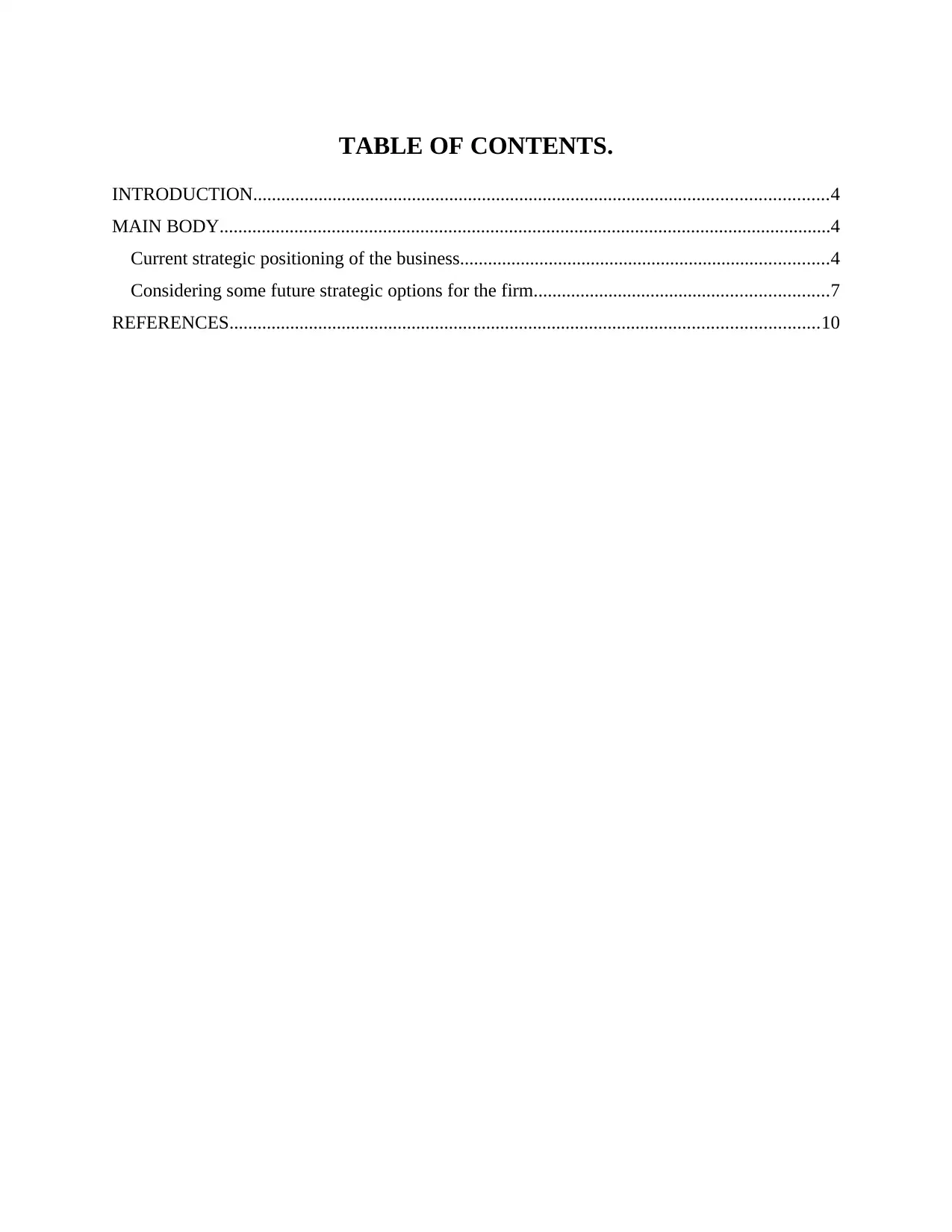
TABLE OF CONTENTS.
INTRODUCTION...........................................................................................................................4
MAIN BODY...................................................................................................................................4
Current strategic positioning of the business...............................................................................4
Considering some future strategic options for the firm...............................................................7
REFERENCES..............................................................................................................................10
INTRODUCTION...........................................................................................................................4
MAIN BODY...................................................................................................................................4
Current strategic positioning of the business...............................................................................4
Considering some future strategic options for the firm...............................................................7
REFERENCES..............................................................................................................................10
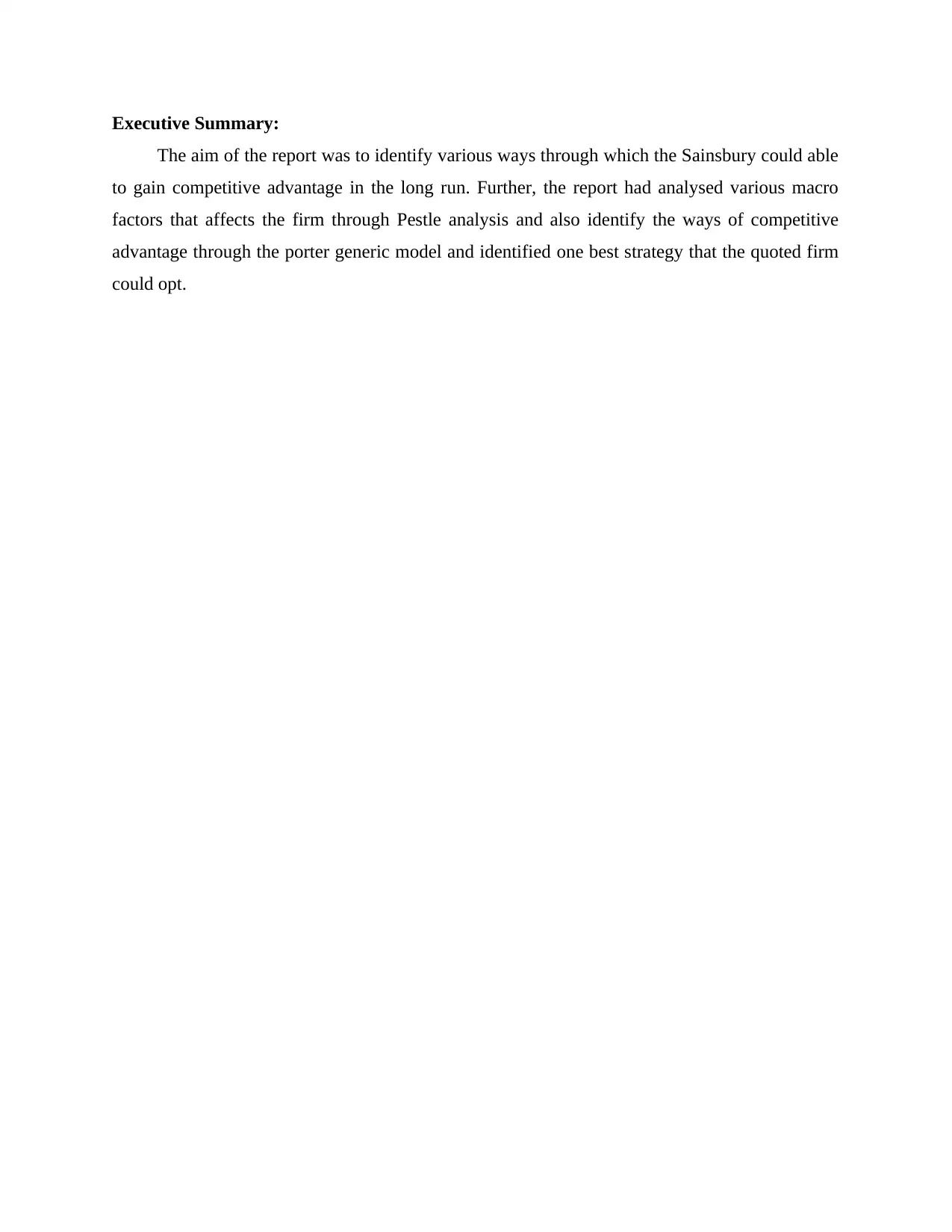
Executive Summary:
The aim of the report was to identify various ways through which the Sainsbury could able
to gain competitive advantage in the long run. Further, the report had analysed various macro
factors that affects the firm through Pestle analysis and also identify the ways of competitive
advantage through the porter generic model and identified one best strategy that the quoted firm
could opt.
The aim of the report was to identify various ways through which the Sainsbury could able
to gain competitive advantage in the long run. Further, the report had analysed various macro
factors that affects the firm through Pestle analysis and also identify the ways of competitive
advantage through the porter generic model and identified one best strategy that the quoted firm
could opt.
⊘ This is a preview!⊘
Do you want full access?
Subscribe today to unlock all pages.

Trusted by 1+ million students worldwide
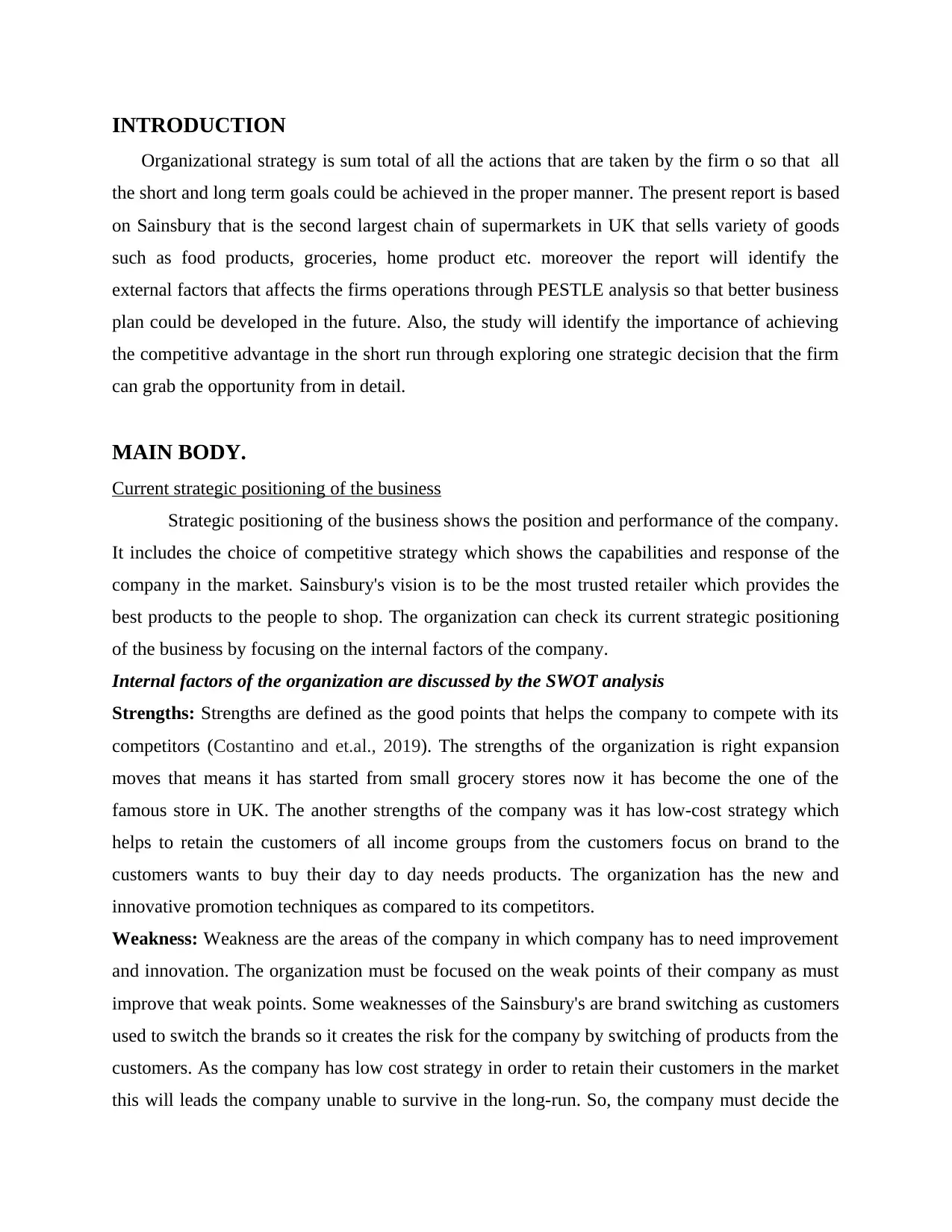
INTRODUCTION
Organizational strategy is sum total of all the actions that are taken by the firm o so that all
the short and long term goals could be achieved in the proper manner. The present report is based
on Sainsbury that is the second largest chain of supermarkets in UK that sells variety of goods
such as food products, groceries, home product etc. moreover the report will identify the
external factors that affects the firms operations through PESTLE analysis so that better business
plan could be developed in the future. Also, the study will identify the importance of achieving
the competitive advantage in the short run through exploring one strategic decision that the firm
can grab the opportunity from in detail.
MAIN BODY.
Current strategic positioning of the business
Strategic positioning of the business shows the position and performance of the company.
It includes the choice of competitive strategy which shows the capabilities and response of the
company in the market. Sainsbury's vision is to be the most trusted retailer which provides the
best products to the people to shop. The organization can check its current strategic positioning
of the business by focusing on the internal factors of the company.
Internal factors of the organization are discussed by the SWOT analysis
Strengths: Strengths are defined as the good points that helps the company to compete with its
competitors (Costantino and et.al., 2019). The strengths of the organization is right expansion
moves that means it has started from small grocery stores now it has become the one of the
famous store in UK. The another strengths of the company was it has low-cost strategy which
helps to retain the customers of all income groups from the customers focus on brand to the
customers wants to buy their day to day needs products. The organization has the new and
innovative promotion techniques as compared to its competitors.
Weakness: Weakness are the areas of the company in which company has to need improvement
and innovation. The organization must be focused on the weak points of their company as must
improve that weak points. Some weaknesses of the Sainsbury's are brand switching as customers
used to switch the brands so it creates the risk for the company by switching of products from the
customers. As the company has low cost strategy in order to retain their customers in the market
this will leads the company unable to survive in the long-run. So, the company must decide the
Organizational strategy is sum total of all the actions that are taken by the firm o so that all
the short and long term goals could be achieved in the proper manner. The present report is based
on Sainsbury that is the second largest chain of supermarkets in UK that sells variety of goods
such as food products, groceries, home product etc. moreover the report will identify the
external factors that affects the firms operations through PESTLE analysis so that better business
plan could be developed in the future. Also, the study will identify the importance of achieving
the competitive advantage in the short run through exploring one strategic decision that the firm
can grab the opportunity from in detail.
MAIN BODY.
Current strategic positioning of the business
Strategic positioning of the business shows the position and performance of the company.
It includes the choice of competitive strategy which shows the capabilities and response of the
company in the market. Sainsbury's vision is to be the most trusted retailer which provides the
best products to the people to shop. The organization can check its current strategic positioning
of the business by focusing on the internal factors of the company.
Internal factors of the organization are discussed by the SWOT analysis
Strengths: Strengths are defined as the good points that helps the company to compete with its
competitors (Costantino and et.al., 2019). The strengths of the organization is right expansion
moves that means it has started from small grocery stores now it has become the one of the
famous store in UK. The another strengths of the company was it has low-cost strategy which
helps to retain the customers of all income groups from the customers focus on brand to the
customers wants to buy their day to day needs products. The organization has the new and
innovative promotion techniques as compared to its competitors.
Weakness: Weakness are the areas of the company in which company has to need improvement
and innovation. The organization must be focused on the weak points of their company as must
improve that weak points. Some weaknesses of the Sainsbury's are brand switching as customers
used to switch the brands so it creates the risk for the company by switching of products from the
customers. As the company has low cost strategy in order to retain their customers in the market
this will leads the company unable to survive in the long-run. So, the company must decide the
Paraphrase This Document
Need a fresh take? Get an instant paraphrase of this document with our AI Paraphraser
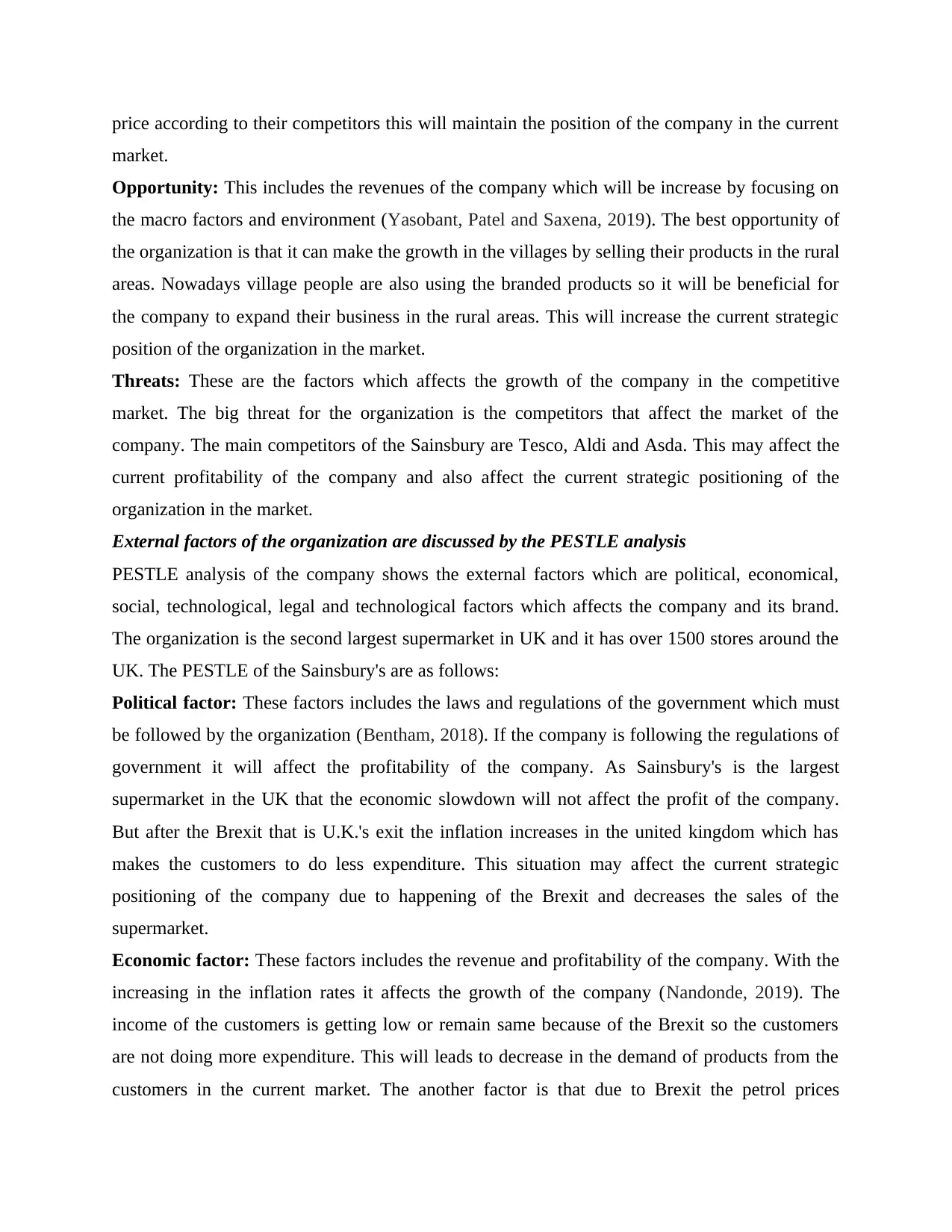
price according to their competitors this will maintain the position of the company in the current
market.
Opportunity: This includes the revenues of the company which will be increase by focusing on
the macro factors and environment (Yasobant, Patel and Saxena, 2019). The best opportunity of
the organization is that it can make the growth in the villages by selling their products in the rural
areas. Nowadays village people are also using the branded products so it will be beneficial for
the company to expand their business in the rural areas. This will increase the current strategic
position of the organization in the market.
Threats: These are the factors which affects the growth of the company in the competitive
market. The big threat for the organization is the competitors that affect the market of the
company. The main competitors of the Sainsbury are Tesco, Aldi and Asda. This may affect the
current profitability of the company and also affect the current strategic positioning of the
organization in the market.
External factors of the organization are discussed by the PESTLE analysis
PESTLE analysis of the company shows the external factors which are political, economical,
social, technological, legal and technological factors which affects the company and its brand.
The organization is the second largest supermarket in UK and it has over 1500 stores around the
UK. The PESTLE of the Sainsbury's are as follows:
Political factor: These factors includes the laws and regulations of the government which must
be followed by the organization (Bentham, 2018). If the company is following the regulations of
government it will affect the profitability of the company. As Sainsbury's is the largest
supermarket in the UK that the economic slowdown will not affect the profit of the company.
But after the Brexit that is U.K.'s exit the inflation increases in the united kingdom which has
makes the customers to do less expenditure. This situation may affect the current strategic
positioning of the company due to happening of the Brexit and decreases the sales of the
supermarket.
Economic factor: These factors includes the revenue and profitability of the company. With the
increasing in the inflation rates it affects the growth of the company (Nandonde, 2019). The
income of the customers is getting low or remain same because of the Brexit so the customers
are not doing more expenditure. This will leads to decrease in the demand of products from the
customers in the current market. The another factor is that due to Brexit the petrol prices
market.
Opportunity: This includes the revenues of the company which will be increase by focusing on
the macro factors and environment (Yasobant, Patel and Saxena, 2019). The best opportunity of
the organization is that it can make the growth in the villages by selling their products in the rural
areas. Nowadays village people are also using the branded products so it will be beneficial for
the company to expand their business in the rural areas. This will increase the current strategic
position of the organization in the market.
Threats: These are the factors which affects the growth of the company in the competitive
market. The big threat for the organization is the competitors that affect the market of the
company. The main competitors of the Sainsbury are Tesco, Aldi and Asda. This may affect the
current profitability of the company and also affect the current strategic positioning of the
organization in the market.
External factors of the organization are discussed by the PESTLE analysis
PESTLE analysis of the company shows the external factors which are political, economical,
social, technological, legal and technological factors which affects the company and its brand.
The organization is the second largest supermarket in UK and it has over 1500 stores around the
UK. The PESTLE of the Sainsbury's are as follows:
Political factor: These factors includes the laws and regulations of the government which must
be followed by the organization (Bentham, 2018). If the company is following the regulations of
government it will affect the profitability of the company. As Sainsbury's is the largest
supermarket in the UK that the economic slowdown will not affect the profit of the company.
But after the Brexit that is U.K.'s exit the inflation increases in the united kingdom which has
makes the customers to do less expenditure. This situation may affect the current strategic
positioning of the company due to happening of the Brexit and decreases the sales of the
supermarket.
Economic factor: These factors includes the revenue and profitability of the company. With the
increasing in the inflation rates it affects the growth of the company (Nandonde, 2019). The
income of the customers is getting low or remain same because of the Brexit so the customers
are not doing more expenditure. This will leads to decrease in the demand of products from the
customers in the current market. The another factor is that due to Brexit the petrol prices
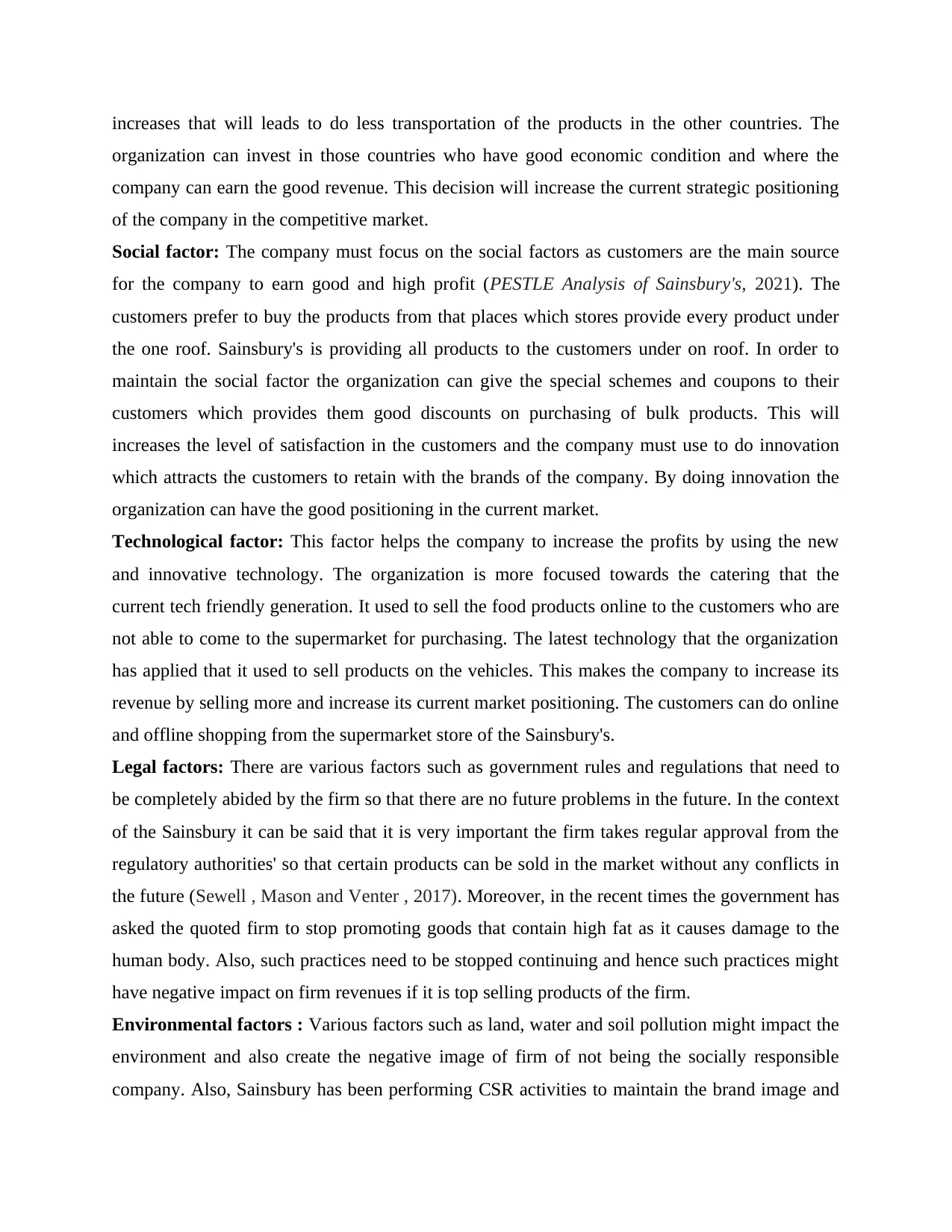
increases that will leads to do less transportation of the products in the other countries. The
organization can invest in those countries who have good economic condition and where the
company can earn the good revenue. This decision will increase the current strategic positioning
of the company in the competitive market.
Social factor: The company must focus on the social factors as customers are the main source
for the company to earn good and high profit (PESTLE Analysis of Sainsbury's, 2021). The
customers prefer to buy the products from that places which stores provide every product under
the one roof. Sainsbury's is providing all products to the customers under on roof. In order to
maintain the social factor the organization can give the special schemes and coupons to their
customers which provides them good discounts on purchasing of bulk products. This will
increases the level of satisfaction in the customers and the company must use to do innovation
which attracts the customers to retain with the brands of the company. By doing innovation the
organization can have the good positioning in the current market.
Technological factor: This factor helps the company to increase the profits by using the new
and innovative technology. The organization is more focused towards the catering that the
current tech friendly generation. It used to sell the food products online to the customers who are
not able to come to the supermarket for purchasing. The latest technology that the organization
has applied that it used to sell products on the vehicles. This makes the company to increase its
revenue by selling more and increase its current market positioning. The customers can do online
and offline shopping from the supermarket store of the Sainsbury's.
Legal factors: There are various factors such as government rules and regulations that need to
be completely abided by the firm so that there are no future problems in the future. In the context
of the Sainsbury it can be said that it is very important the firm takes regular approval from the
regulatory authorities' so that certain products can be sold in the market without any conflicts in
the future (Sewell , Mason and Venter , 2017). Moreover, in the recent times the government has
asked the quoted firm to stop promoting goods that contain high fat as it causes damage to the
human body. Also, such practices need to be stopped continuing and hence such practices might
have negative impact on firm revenues if it is top selling products of the firm.
Environmental factors : Various factors such as land, water and soil pollution might impact the
environment and also create the negative image of firm of not being the socially responsible
company. Also, Sainsbury has been performing CSR activities to maintain the brand image and
organization can invest in those countries who have good economic condition and where the
company can earn the good revenue. This decision will increase the current strategic positioning
of the company in the competitive market.
Social factor: The company must focus on the social factors as customers are the main source
for the company to earn good and high profit (PESTLE Analysis of Sainsbury's, 2021). The
customers prefer to buy the products from that places which stores provide every product under
the one roof. Sainsbury's is providing all products to the customers under on roof. In order to
maintain the social factor the organization can give the special schemes and coupons to their
customers which provides them good discounts on purchasing of bulk products. This will
increases the level of satisfaction in the customers and the company must use to do innovation
which attracts the customers to retain with the brands of the company. By doing innovation the
organization can have the good positioning in the current market.
Technological factor: This factor helps the company to increase the profits by using the new
and innovative technology. The organization is more focused towards the catering that the
current tech friendly generation. It used to sell the food products online to the customers who are
not able to come to the supermarket for purchasing. The latest technology that the organization
has applied that it used to sell products on the vehicles. This makes the company to increase its
revenue by selling more and increase its current market positioning. The customers can do online
and offline shopping from the supermarket store of the Sainsbury's.
Legal factors: There are various factors such as government rules and regulations that need to
be completely abided by the firm so that there are no future problems in the future. In the context
of the Sainsbury it can be said that it is very important the firm takes regular approval from the
regulatory authorities' so that certain products can be sold in the market without any conflicts in
the future (Sewell , Mason and Venter , 2017). Moreover, in the recent times the government has
asked the quoted firm to stop promoting goods that contain high fat as it causes damage to the
human body. Also, such practices need to be stopped continuing and hence such practices might
have negative impact on firm revenues if it is top selling products of the firm.
Environmental factors : Various factors such as land, water and soil pollution might impact the
environment and also create the negative image of firm of not being the socially responsible
company. Also, Sainsbury has been performing CSR activities to maintain the brand image and
⊘ This is a preview!⊘
Do you want full access?
Subscribe today to unlock all pages.

Trusted by 1+ million students worldwide
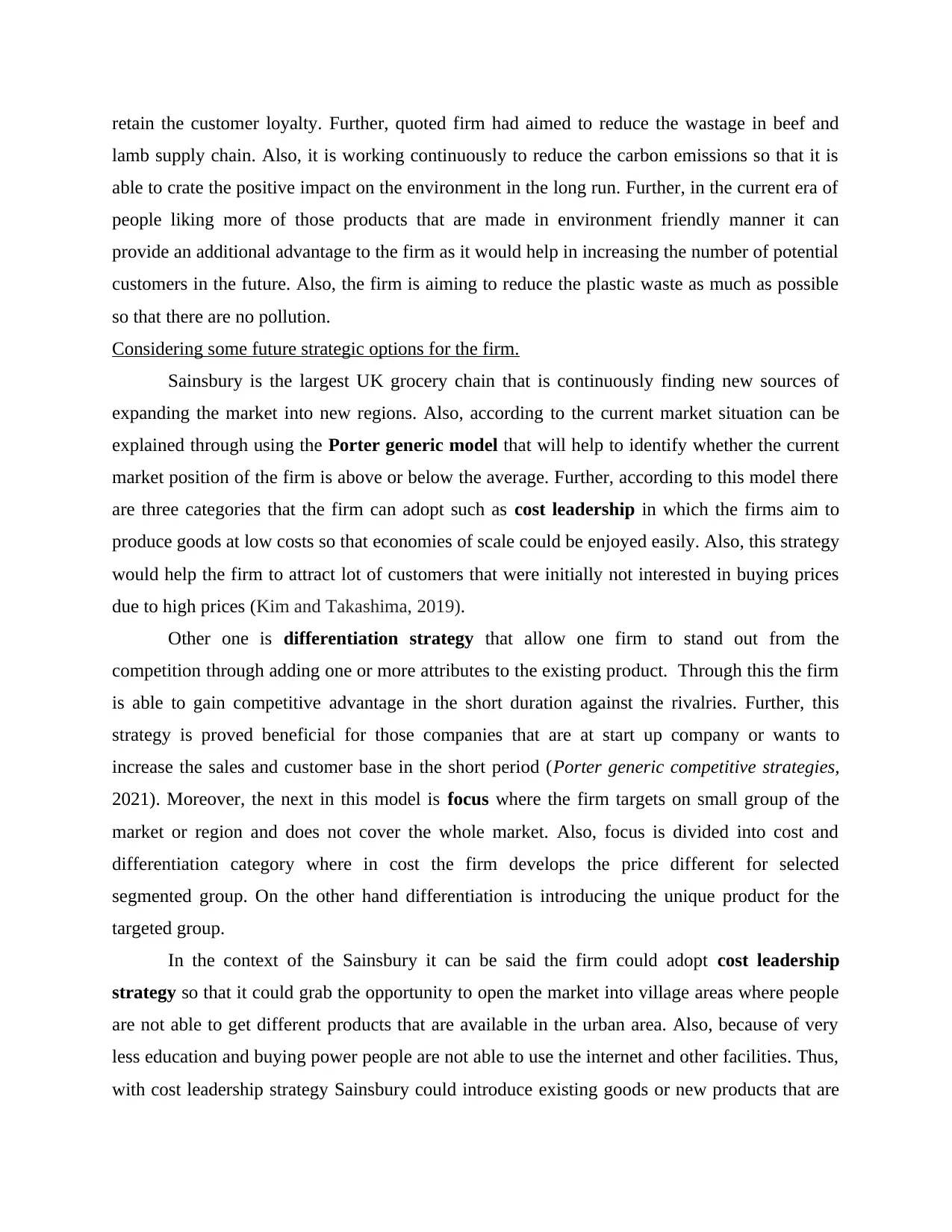
retain the customer loyalty. Further, quoted firm had aimed to reduce the wastage in beef and
lamb supply chain. Also, it is working continuously to reduce the carbon emissions so that it is
able to crate the positive impact on the environment in the long run. Further, in the current era of
people liking more of those products that are made in environment friendly manner it can
provide an additional advantage to the firm as it would help in increasing the number of potential
customers in the future. Also, the firm is aiming to reduce the plastic waste as much as possible
so that there are no pollution.
Considering some future strategic options for the firm.
Sainsbury is the largest UK grocery chain that is continuously finding new sources of
expanding the market into new regions. Also, according to the current market situation can be
explained through using the Porter generic model that will help to identify whether the current
market position of the firm is above or below the average. Further, according to this model there
are three categories that the firm can adopt such as cost leadership in which the firms aim to
produce goods at low costs so that economies of scale could be enjoyed easily. Also, this strategy
would help the firm to attract lot of customers that were initially not interested in buying prices
due to high prices (Kim and Takashima, 2019).
Other one is differentiation strategy that allow one firm to stand out from the
competition through adding one or more attributes to the existing product. Through this the firm
is able to gain competitive advantage in the short duration against the rivalries. Further, this
strategy is proved beneficial for those companies that are at start up company or wants to
increase the sales and customer base in the short period (Porter generic competitive strategies,
2021). Moreover, the next in this model is focus where the firm targets on small group of the
market or region and does not cover the whole market. Also, focus is divided into cost and
differentiation category where in cost the firm develops the price different for selected
segmented group. On the other hand differentiation is introducing the unique product for the
targeted group.
In the context of the Sainsbury it can be said the firm could adopt cost leadership
strategy so that it could grab the opportunity to open the market into village areas where people
are not able to get different products that are available in the urban area. Also, because of very
less education and buying power people are not able to use the internet and other facilities. Thus,
with cost leadership strategy Sainsbury could introduce existing goods or new products that are
lamb supply chain. Also, it is working continuously to reduce the carbon emissions so that it is
able to crate the positive impact on the environment in the long run. Further, in the current era of
people liking more of those products that are made in environment friendly manner it can
provide an additional advantage to the firm as it would help in increasing the number of potential
customers in the future. Also, the firm is aiming to reduce the plastic waste as much as possible
so that there are no pollution.
Considering some future strategic options for the firm.
Sainsbury is the largest UK grocery chain that is continuously finding new sources of
expanding the market into new regions. Also, according to the current market situation can be
explained through using the Porter generic model that will help to identify whether the current
market position of the firm is above or below the average. Further, according to this model there
are three categories that the firm can adopt such as cost leadership in which the firms aim to
produce goods at low costs so that economies of scale could be enjoyed easily. Also, this strategy
would help the firm to attract lot of customers that were initially not interested in buying prices
due to high prices (Kim and Takashima, 2019).
Other one is differentiation strategy that allow one firm to stand out from the
competition through adding one or more attributes to the existing product. Through this the firm
is able to gain competitive advantage in the short duration against the rivalries. Further, this
strategy is proved beneficial for those companies that are at start up company or wants to
increase the sales and customer base in the short period (Porter generic competitive strategies,
2021). Moreover, the next in this model is focus where the firm targets on small group of the
market or region and does not cover the whole market. Also, focus is divided into cost and
differentiation category where in cost the firm develops the price different for selected
segmented group. On the other hand differentiation is introducing the unique product for the
targeted group.
In the context of the Sainsbury it can be said the firm could adopt cost leadership
strategy so that it could grab the opportunity to open the market into village areas where people
are not able to get different products that are available in the urban area. Also, because of very
less education and buying power people are not able to use the internet and other facilities. Thus,
with cost leadership strategy Sainsbury could introduce existing goods or new products that are
Paraphrase This Document
Need a fresh take? Get an instant paraphrase of this document with our AI Paraphraser

relatively of low costs so that individual could easily consume variety of products (Maixé-
Altés, , 2018). Further this strategy would be helpful for the firm to generate excessive revenues
from new regions. Also, this would be positive as it would allow easy expansion option to the
firm. However, for this strategy to be successful it is very important that proper research is
undertaken so that there are no losses in the future. Also, government policies and trade
restrictions need to be identified so that there no problems in future successful operations.
Further, to be cost effective it is needed that the firm is able to identify resources that are
available at the low costs so that manufacturing costs can be minimized (Najjar, Small and
Yasin , 2020). Moreover, though this Sainsbury would be able to reduce excessive competition
that is going to occur at one marketplace where all the competitors aims to be ahead in the
competition. In the new market it would be hence not easy for the other competitors to easily
achieve the same price level offered by the Sainsbury.
Also, it is seen that the firm would be able to have sustainability of the business in the
local economy as in any case of financial threats in the future it gives an additional advantage to
the quoted firm as consumers would purchase only those products that are available at relatively
lower price than the rivalries (Papaioannou and et.al., 2018). Moreover, it is seen that quoted
firm will have an advantage of having efficient distribution channels that would allow the
consumers living in different regions to consume goods either through online or offline medium
that is through the physical stores or through online website of the Sainsbury.
However, it is very crucial that quoted firm analysis various aspects before implementing
such strategy in the market. For example : Customer service department is very important for any
organization so that all the queries and feedback relating to the customers could be solved easily
when it arises in the future. However, if Sainsbury reduce the prices under this department to
serve the products at low cost in any market than there are chances that it may create negative
impact on the image of the firm if the buyers value this department very seriously (Picot-Coupey,
, Viviani and Amadieu , 2018). Also, it is seen that this type of strategy might reduce the overall
efficiency of the firm to innovate various products that means that Sainsbury would reduce the
investment in the research and development department to bring down the costs. Thus, this might
not allow the big retailer, like the quoted firm to bring new products in the existing markets
where there is stiff competition. Moreover, in retail sector this type of technique is quickly
Altés, , 2018). Further this strategy would be helpful for the firm to generate excessive revenues
from new regions. Also, this would be positive as it would allow easy expansion option to the
firm. However, for this strategy to be successful it is very important that proper research is
undertaken so that there are no losses in the future. Also, government policies and trade
restrictions need to be identified so that there no problems in future successful operations.
Further, to be cost effective it is needed that the firm is able to identify resources that are
available at the low costs so that manufacturing costs can be minimized (Najjar, Small and
Yasin , 2020). Moreover, though this Sainsbury would be able to reduce excessive competition
that is going to occur at one marketplace where all the competitors aims to be ahead in the
competition. In the new market it would be hence not easy for the other competitors to easily
achieve the same price level offered by the Sainsbury.
Also, it is seen that the firm would be able to have sustainability of the business in the
local economy as in any case of financial threats in the future it gives an additional advantage to
the quoted firm as consumers would purchase only those products that are available at relatively
lower price than the rivalries (Papaioannou and et.al., 2018). Moreover, it is seen that quoted
firm will have an advantage of having efficient distribution channels that would allow the
consumers living in different regions to consume goods either through online or offline medium
that is through the physical stores or through online website of the Sainsbury.
However, it is very crucial that quoted firm analysis various aspects before implementing
such strategy in the market. For example : Customer service department is very important for any
organization so that all the queries and feedback relating to the customers could be solved easily
when it arises in the future. However, if Sainsbury reduce the prices under this department to
serve the products at low cost in any market than there are chances that it may create negative
impact on the image of the firm if the buyers value this department very seriously (Picot-Coupey,
, Viviani and Amadieu , 2018). Also, it is seen that this type of strategy might reduce the overall
efficiency of the firm to innovate various products that means that Sainsbury would reduce the
investment in the research and development department to bring down the costs. Thus, this might
not allow the big retailer, like the quoted firm to bring new products in the existing markets
where there is stiff competition. Moreover, in retail sector this type of technique is quickly
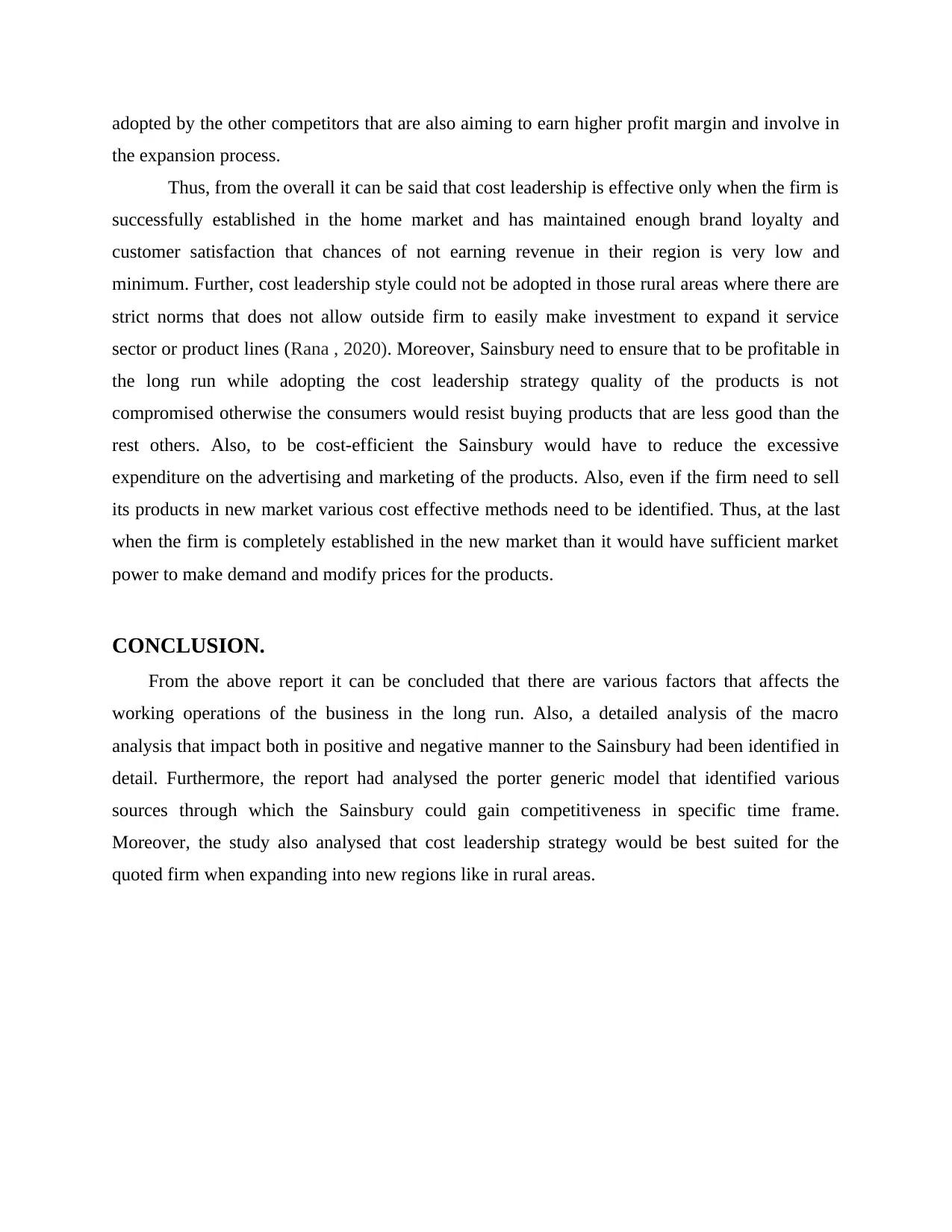
adopted by the other competitors that are also aiming to earn higher profit margin and involve in
the expansion process.
Thus, from the overall it can be said that cost leadership is effective only when the firm is
successfully established in the home market and has maintained enough brand loyalty and
customer satisfaction that chances of not earning revenue in their region is very low and
minimum. Further, cost leadership style could not be adopted in those rural areas where there are
strict norms that does not allow outside firm to easily make investment to expand it service
sector or product lines (Rana , 2020). Moreover, Sainsbury need to ensure that to be profitable in
the long run while adopting the cost leadership strategy quality of the products is not
compromised otherwise the consumers would resist buying products that are less good than the
rest others. Also, to be cost-efficient the Sainsbury would have to reduce the excessive
expenditure on the advertising and marketing of the products. Also, even if the firm need to sell
its products in new market various cost effective methods need to be identified. Thus, at the last
when the firm is completely established in the new market than it would have sufficient market
power to make demand and modify prices for the products.
CONCLUSION.
From the above report it can be concluded that there are various factors that affects the
working operations of the business in the long run. Also, a detailed analysis of the macro
analysis that impact both in positive and negative manner to the Sainsbury had been identified in
detail. Furthermore, the report had analysed the porter generic model that identified various
sources through which the Sainsbury could gain competitiveness in specific time frame.
Moreover, the study also analysed that cost leadership strategy would be best suited for the
quoted firm when expanding into new regions like in rural areas.
the expansion process.
Thus, from the overall it can be said that cost leadership is effective only when the firm is
successfully established in the home market and has maintained enough brand loyalty and
customer satisfaction that chances of not earning revenue in their region is very low and
minimum. Further, cost leadership style could not be adopted in those rural areas where there are
strict norms that does not allow outside firm to easily make investment to expand it service
sector or product lines (Rana , 2020). Moreover, Sainsbury need to ensure that to be profitable in
the long run while adopting the cost leadership strategy quality of the products is not
compromised otherwise the consumers would resist buying products that are less good than the
rest others. Also, to be cost-efficient the Sainsbury would have to reduce the excessive
expenditure on the advertising and marketing of the products. Also, even if the firm need to sell
its products in new market various cost effective methods need to be identified. Thus, at the last
when the firm is completely established in the new market than it would have sufficient market
power to make demand and modify prices for the products.
CONCLUSION.
From the above report it can be concluded that there are various factors that affects the
working operations of the business in the long run. Also, a detailed analysis of the macro
analysis that impact both in positive and negative manner to the Sainsbury had been identified in
detail. Furthermore, the report had analysed the porter generic model that identified various
sources through which the Sainsbury could gain competitiveness in specific time frame.
Moreover, the study also analysed that cost leadership strategy would be best suited for the
quoted firm when expanding into new regions like in rural areas.
⊘ This is a preview!⊘
Do you want full access?
Subscribe today to unlock all pages.

Trusted by 1+ million students worldwide
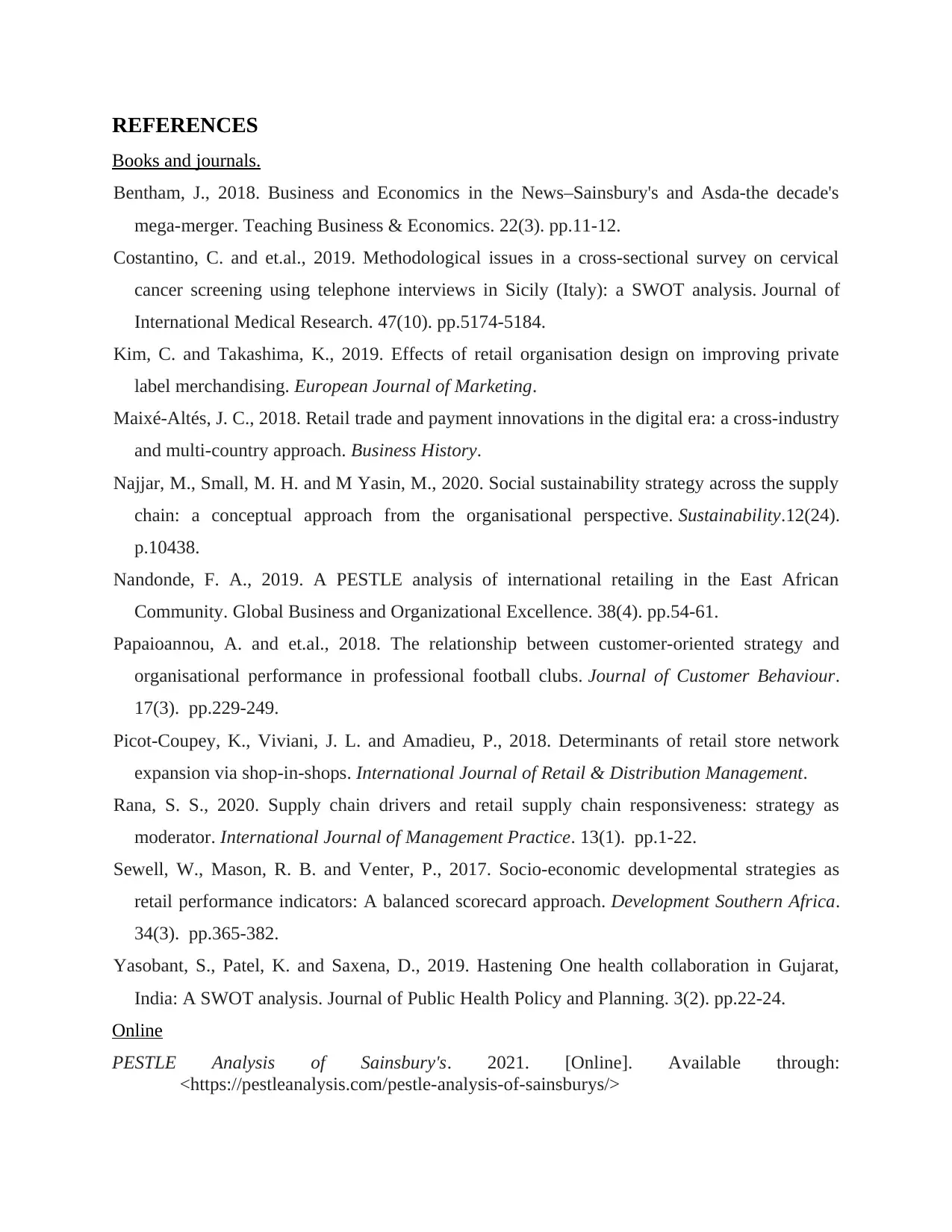
REFERENCES
Books and journals.
Bentham, J., 2018. Business and Economics in the News–Sainsbury's and Asda-the decade's
mega-merger. Teaching Business & Economics. 22(3). pp.11-12.
Costantino, C. and et.al., 2019. Methodological issues in a cross-sectional survey on cervical
cancer screening using telephone interviews in Sicily (Italy): a SWOT analysis. Journal of
International Medical Research. 47(10). pp.5174-5184.
Kim, C. and Takashima, K., 2019. Effects of retail organisation design on improving private
label merchandising. European Journal of Marketing.
Maixé-Altés, J. C., 2018. Retail trade and payment innovations in the digital era: a cross-industry
and multi-country approach. Business History.
Najjar, M., Small, M. H. and M Yasin, M., 2020. Social sustainability strategy across the supply
chain: a conceptual approach from the organisational perspective. Sustainability.12(24).
p.10438.
Nandonde, F. A., 2019. A PESTLE analysis of international retailing in the East African
Community. Global Business and Organizational Excellence. 38(4). pp.54-61.
Papaioannou, A. and et.al., 2018. The relationship between customer-oriented strategy and
organisational performance in professional football clubs. Journal of Customer Behaviour.
17(3). pp.229-249.
Picot-Coupey, K., Viviani, J. L. and Amadieu, P., 2018. Determinants of retail store network
expansion via shop-in-shops. International Journal of Retail & Distribution Management.
Rana, S. S., 2020. Supply chain drivers and retail supply chain responsiveness: strategy as
moderator. International Journal of Management Practice. 13(1). pp.1-22.
Sewell, W., Mason, R. B. and Venter, P., 2017. Socio-economic developmental strategies as
retail performance indicators: A balanced scorecard approach. Development Southern Africa.
34(3). pp.365-382.
Yasobant, S., Patel, K. and Saxena, D., 2019. Hastening One health collaboration in Gujarat,
India: A SWOT analysis. Journal of Public Health Policy and Planning. 3(2). pp.22-24.
Online
PESTLE Analysis of Sainsbury's. 2021. [Online]. Available through:
<https://pestleanalysis.com/pestle-analysis-of-sainsburys/>
Books and journals.
Bentham, J., 2018. Business and Economics in the News–Sainsbury's and Asda-the decade's
mega-merger. Teaching Business & Economics. 22(3). pp.11-12.
Costantino, C. and et.al., 2019. Methodological issues in a cross-sectional survey on cervical
cancer screening using telephone interviews in Sicily (Italy): a SWOT analysis. Journal of
International Medical Research. 47(10). pp.5174-5184.
Kim, C. and Takashima, K., 2019. Effects of retail organisation design on improving private
label merchandising. European Journal of Marketing.
Maixé-Altés, J. C., 2018. Retail trade and payment innovations in the digital era: a cross-industry
and multi-country approach. Business History.
Najjar, M., Small, M. H. and M Yasin, M., 2020. Social sustainability strategy across the supply
chain: a conceptual approach from the organisational perspective. Sustainability.12(24).
p.10438.
Nandonde, F. A., 2019. A PESTLE analysis of international retailing in the East African
Community. Global Business and Organizational Excellence. 38(4). pp.54-61.
Papaioannou, A. and et.al., 2018. The relationship between customer-oriented strategy and
organisational performance in professional football clubs. Journal of Customer Behaviour.
17(3). pp.229-249.
Picot-Coupey, K., Viviani, J. L. and Amadieu, P., 2018. Determinants of retail store network
expansion via shop-in-shops. International Journal of Retail & Distribution Management.
Rana, S. S., 2020. Supply chain drivers and retail supply chain responsiveness: strategy as
moderator. International Journal of Management Practice. 13(1). pp.1-22.
Sewell, W., Mason, R. B. and Venter, P., 2017. Socio-economic developmental strategies as
retail performance indicators: A balanced scorecard approach. Development Southern Africa.
34(3). pp.365-382.
Yasobant, S., Patel, K. and Saxena, D., 2019. Hastening One health collaboration in Gujarat,
India: A SWOT analysis. Journal of Public Health Policy and Planning. 3(2). pp.22-24.
Online
PESTLE Analysis of Sainsbury's. 2021. [Online]. Available through:
<https://pestleanalysis.com/pestle-analysis-of-sainsburys/>
Paraphrase This Document
Need a fresh take? Get an instant paraphrase of this document with our AI Paraphraser
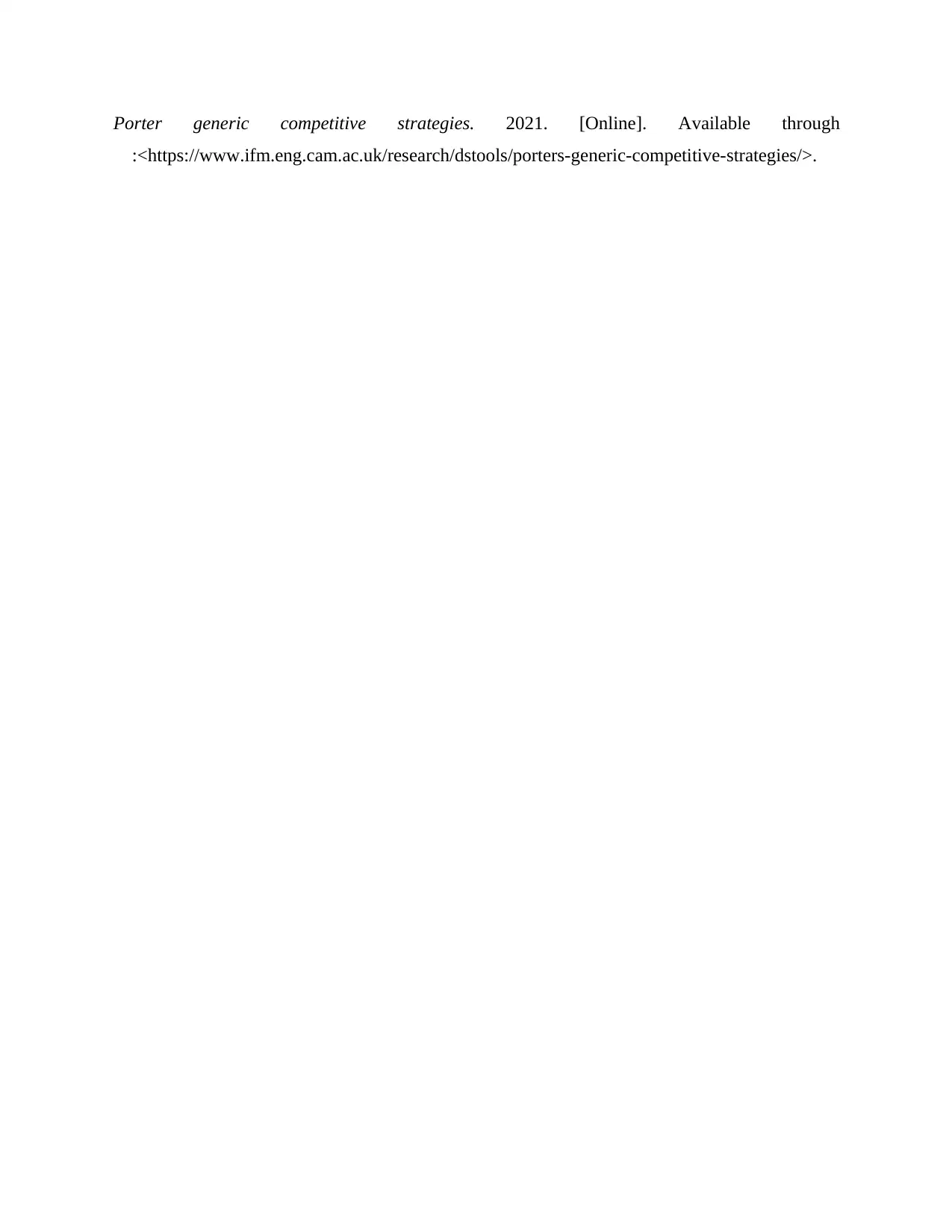
Porter generic competitive strategies. 2021. [Online]. Available through
:<https://www.ifm.eng.cam.ac.uk/research/dstools/porters-generic-competitive-strategies/>.
:<https://www.ifm.eng.cam.ac.uk/research/dstools/porters-generic-competitive-strategies/>.
1 out of 11
Related Documents
Your All-in-One AI-Powered Toolkit for Academic Success.
+13062052269
info@desklib.com
Available 24*7 on WhatsApp / Email
![[object Object]](/_next/static/media/star-bottom.7253800d.svg)
Unlock your academic potential
Copyright © 2020–2025 A2Z Services. All Rights Reserved. Developed and managed by ZUCOL.





